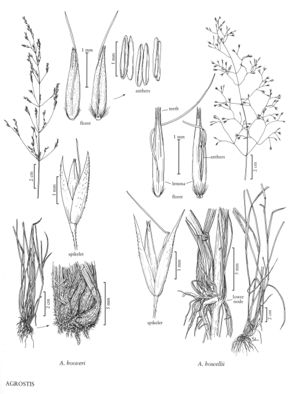Difference between revisions of "Agrostis hooveri"
FNA>Volume Importer |
imported>Volume Importer |
||
| (4 intermediate revisions by 2 users not shown) | |||
| Line 4: | Line 4: | ||
|publications= | |publications= | ||
|common_names=Hoover's bent | |common_names=Hoover's bent | ||
| + | |special_status={{Treatment/ID/Special_status | ||
| + | |code=E | ||
| + | |label=Endemic | ||
| + | }} | ||
|basionyms= | |basionyms= | ||
|synonyms= | |synonyms= | ||
| Line 17: | Line 21: | ||
-->{{Treatment/Body | -->{{Treatment/Body | ||
|distribution=Calif. | |distribution=Calif. | ||
| − | |discussion=<p>Agrostis hooveri is an uncommon species, endemic to dry, sandy soils, open chaparral, and oak woodlands of San Luis Obispo and Santa Barbara counties, California.</p> | + | |discussion=<p><i>Agrostis hooveri</i> is an uncommon species, endemic to dry, sandy soils, open chaparral, and oak woodlands of San Luis Obispo and Santa Barbara counties, California.</p> |
|tables= | |tables= | ||
|references= | |references= | ||
| Line 26: | Line 30: | ||
-->{{#Taxon: | -->{{#Taxon: | ||
name=Agrostis hooveri | name=Agrostis hooveri | ||
| − | |||
|authority=Swallen | |authority=Swallen | ||
|rank=species | |rank=species | ||
| Line 34: | Line 37: | ||
|family=Poaceae | |family=Poaceae | ||
|illustrator=Sandy Long | |illustrator=Sandy Long | ||
| + | |illustration copyright=Utah State University | ||
|distribution=Calif. | |distribution=Calif. | ||
|reference=None | |reference=None | ||
|publication title= | |publication title= | ||
|publication year= | |publication year= | ||
| − | |special status= | + | |special status=Endemic |
| − | |source xml=https:// | + | |source xml=https://bitbucket.org/aafc-mbb/fna-data-curation/src/200273ad09963decb8fc72550212de541d86569d/coarse_grained_fna_xml/V24/V24_922.xml |
|subfamily=Poaceae subfam. Pooideae | |subfamily=Poaceae subfam. Pooideae | ||
|tribe=Poaceae tribe Poeae | |tribe=Poaceae tribe Poeae | ||
Latest revision as of 17:26, 11 May 2021
Plants perennial; cespitose, not rhizomatous, not stoloniferous. Culms 30-80 cm, erect, usually with more than 3 nodes. Leaves mostly on the lower 1/2 of the culm; basal leaves withered by anthesis; lower leaf sheaths finely tomentose, the tomentum extending to below ground; upper leaf sheaths smooth; ligules 2.5-6 mm, dorsal surfaces scabridulous, apices acute to truncate, lacerate; blades 10-16 cm long, 0.5-1(2) mm wide, flat, becoming involute. Panicles (4)10-17 cm long, 2-5 cm wide, broadly lanceolate, usually open, exserted from the upper sheaths at maturity, lowest node with 1-8 branches; branches scabrous, generally ascending, mostly branching at about midlength, sometimes to near the base, lower branches 1.5-5 cm; pedicels 0.4-5 mm. Spikelets lanceolate, slightly purplish. Glumes equal to subequal, 1.8-3 mm, 1-veined, scabridulous on the veins, sometimes also on the body, acute; callus hairs to 0.3 mm, abundant; lemmas 1.5-2 mm, scabridulous to warty throughout or only on the veins, translucent to opaque, 5-veined, veins prominent distally, apices truncate, minutely toothed to about 0.2 mm, awned on the lower 1/3, awns to 2.5 mm, geniculate, persistent; paleas absent or minute; anthers 3, 1-1.5 mm, usually shed at anthesis. Caryopses 1-1.5 mm; endosperm liquid. 2n = unknown.
Discussion
Agrostis hooveri is an uncommon species, endemic to dry, sandy soils, open chaparral, and oak woodlands of San Luis Obispo and Santa Barbara counties, California.
Selected References
None.
